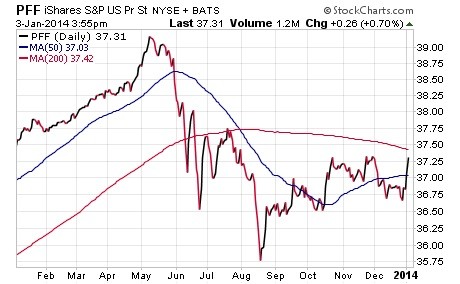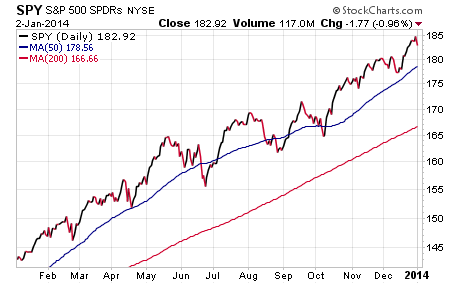2014 ETF Income Investing Ideas Part 1
Post on: 13 Июнь, 2015 No Comment

Income investors face a brave new world in 2014 that is punctuated by real interest rates trending higher and the Federal Reserve slowly reducing the pace of their quantitative easing measures. This has led to fears of a massive shift in asset allocation from traditional fixed-income to equities and alternative investments. In fact, many have abandoned bonds altogether and have sworn off owning them for the foreseeable future. On the flip side, stalwart income seekers have shifted a tremendous amount of their holdings to short duration or credit sensitive holdings which have thrived in 2013.
The key to success in 2014 will be to strike a balance between credit, duration, and sector exposure to achieve positive returns in fixed-income. One thing that can’t be discounted is the level of income, diversification, and low volatility that is needed by retirees, pensions, and a host of other conservative investors. Bond’s shouldn’t be ignored, but rather implemented in a strategic manner to achieve your investment goals with the knowledge that there may be speed bumps along the way.
The following are some of my thoughts pertaining to opportunities and risks in bonds over the next 12 months.
Most investors perceive rising interest rates to be the biggest risk to bond holders over the next year. There are a number of ways that ETF investors can combat rising rates. One such method would be to purchase a rising rate fund such as the ProShares 20+ Year Short Treasury ETF (NYSEARCA:TBF ). This fund essentially moves in the same direction as long-term interest rates and can hedge off a portion of the volatility in your fixed-income portfolio.
At this stage, it’s important to remember that interest rates have already risen considerably since their 2013 low. They will more than likely continue to meander through 2014 with a variety of ups and downs along the way. If you are planning on shorting treasury bonds, make sure that you do so with a risk management approach that takes into account the potential for deflation.
Another method of insulation would be to shorten your average portfolio duration. An example of which would be to move from the iShares Aggregate Bond ETF (NYSEARCA:AGG ) to the Vanguard Short Duration Bond ETF (NYSEARCA:BSV ). This would lower the effective maturity dates of the bonds in your portfolio, but also quite drastically reduce your monthly income stream. If you are dependent on the dividends from your investments, this strategy may eat into your capital over time.
Both of these strategies have been effective combatants for rising rates in 2013 as billions of dollars have shifted in this general direction. However, there are a host of perils other than rising rates that may become a reality if certain conditions are met.
With the shortening of duration, many investors have taken on more credit risk than historical norms. This has created what many describe as a bubble in high yield debt that has the potential to unwind if we start to see an economic slowdown or rush for the exits. A stumble in the stock market could trip up junk bonds and send money fleeing from equities and credit sensitive holdings.
Right now we are still in an uptrend with respect to high yield. bank loans, and convertible bonds which is why I am recommending you hold on to your exposure in these areas. However, I am closely monitoring these high yield sectors for signs of a reversal which would warrant moving a portion of capital back to more quality holdings such as the iShares Investment Grade Corporate Bond ETF (NYSEARCA:LQD ) or the iShares MBS ETF (NYSEARCA:MBB ). These ETFs, along with treasuries, would likely do well in a deflationary environment under the scenarios of a flight to quality.
Another correlation I am monitoring with respect to high yield is the divergence between U.S. high yield corporate debt and emerging market bonds of a similar credit quality. Consider that the iShares High Yield Corporate Bond ETF (NYSEARCA:HYG ) is trading near all-time highs and has a comparable yield to the WisdomTree Emerging Market Corporate Bond ETF (NASDAQ:EMCB ). However, EMCB is still more than 5% off its high water mark. I expect that this divergence will eventually correct and we could see money flow into emerging markets as fixed-income investors find more value and diversification overseas next year.

Conclusions
Picking the right fixed-income ETF or mutual fund that suits your needs is all about evaluating your risk tolerance and investment objectives. You should do some analysis of top performing funds from previous years and ask yourself how they will perform under certain scenarios. If the Fed decides to speed up or slow down it’s taper agenda, you may have to shift your portfolio to cope with changing dynamics. In addition, it’s important to keep an eye on the health of equity and credit sensitive markets as these will impact the bond market in the coming year ahead.
One actively managed mutual fund that is one of my favorite core holdings is the PIMCO Income Fund (MUTF:PONDX ) which takes a multi-sector approach to specific areas of the bond market that the manager feels will outperform. They have done a fantastic job of managing interest rate risk in 2013 and taking advantage of opportunities (both inside and outside the U.S.) when they are available. This has led to year-to-date returns approaching 4.5%, an effective duration of less than 5 years, and a current 30-day SEC yield of nearly 4%.
In a following series of articles, I will detail my thoughts on equities and alternative investments for income investors in 2014. As you are evaluating your portfolio heading into the new year, make sure that you stay balanced and agile with respect to opportunities and risks that may present themselves. That way you are prepared with a game plan to shift your asset allocation when needed and overcome any obstacles that you may encounter. Here’s to a healthy and wealthy New Year!
Disclosure: I am long HYG. I wrote this article myself, and it expresses my own opinions. I am not receiving compensation for it. I have no business relationship with any company whose stock is mentioned in this article.
Additional disclosure: David Fabian, FMD Capital Management, and/or its clients may hold positions in the ETFs and mutual funds mentioned above. The commentary does not constitute individualized investment advice. The opinions offered herein are not personalized recommendations to buy, sell or hold securities.














